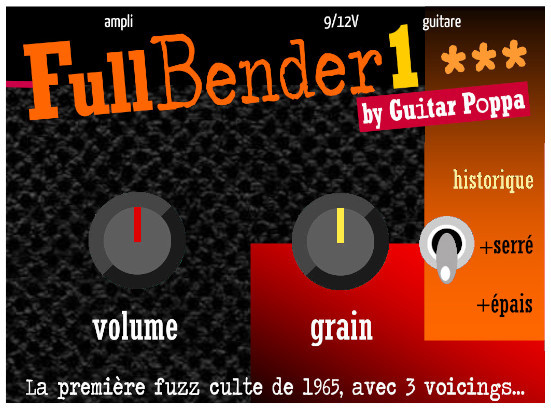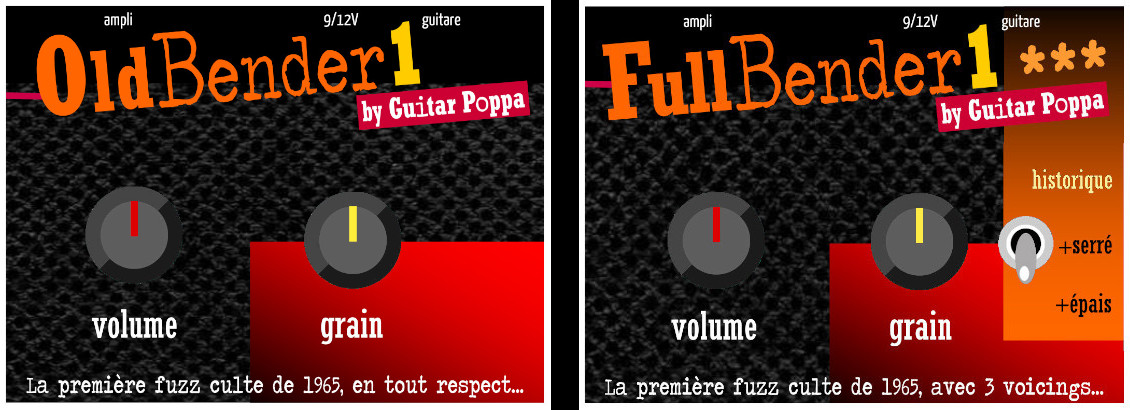FullBender1 is inspired by the Tone Bender® Mk1,
an historic fuzz designed in 1965 by Gary Hurst.
It was not many distributed, being ahead of fashion, and too quickly forgotten in favor of later models from Tone BendOne finally rediscovered it during the vintage fashion of the 90s, et reevaluated because it offered a hairy and dense fuzzy sound, with nice dynamic gate effects…


The first prototype of the FullBender1 which was still called SoftBender1.
General features
• Historical circuitry of the ToneBender Mk1, taken and developed with a critical fidelity.
• 3 sorted NOS germanium transistors.
• 3 voicings: historical; +tight; +thick.
• TrueBypass switching without buffer, for operation as close as possible to the guitar pick ups.
For the purists :
• The OldBender1 version, without voicing switch,
focuses on the unique grain of the ToneBender Mk1.
Samples (coming soon…)

FullBender1 works with a 9V battery, or a 9 to 12V external power supply
(2.1mm coaxial plug, center negative). Total consumption: 7mA.
An internal active filter suppresses noise caused by low-end power supplies.
As with any germanium circuit, FullBender1 performs its best after 5 to 10 minutes under voltage: the time for the internal currents to have balanced in the germanium crystals and its internal temperature to have stabilized…

Two available models
OldBender1 FullBender1
OldBender1
Old school fuzz close to the historic ToneBender Mk1.
1590BB aluminium cast enclosure (120x93x36mm)
Some components have been recalculated to improve bias and thermal stability.
NOS transistors used:
— 2 NOS OC75 Philips germanium transistors as preamps…
— 1 NOS ГT4125, GC301 or AC128 germanium transistor as final saturator.
2 potentiometers:
— Volume: adjusts the output level from 0 to 600mV.
— Grain: defines the fuzz effect, in particular the gate effect and the duty cycle.
Unique voicing reproducing the original grain of the Tone Bender Mk1.
True ByPass switching.
FullBender1
Tone Bender Mk1 circuit completed by GuitarPoppa.
1590BB aluminium cast enclosure (120x93x36mm)
Same NOS transistors as in the OldBender1 version.
Same critical fidelity to the ToneBender circuit, and same adjustments when necessary.
Special features:
3 voicings:
— Historic: Gain, grain and bandwidth of the original Tone Bender.
— +tight: Tightened bass, present mid-treble, for a classic rock sound.
— +thick: High gain and denser grain providing a very fat old school fuzz…
True ByPass switching.

Detail of the card, with the three vintage transistors…

To order…
1. Choose a version…
2. Specify the shipping zone.
3. Click <add to order>.
4. Click <Shopping Cart> on the main menu to finalize.

 FullBender1
FullBender1
unique version
149 €
Development of the Tone Bender Mk1.
2 controls and a switch with 3 voicings.
FullBender1
Shipping fees (Colissimo with signature)
France : 8€ — CE+Switzerland : 14€ — Other countries : 24€

 OldBender1
OldBender1
basic version
129 €
True to the Tone Bender Mk1 layout.
2 controls.
No special voicings
LikeYourFace ***
Shipping fees (Colissimo with signature)
France : 8€ — CE+Switzerland : 14€ — Other countries : 24€
To know more
The several effects of the Grain control
This is more a bias control than a distorsion amount control
The distortion remains generous, but the Grain knob adjusts two parameters which will modulate the dynamics and the sound texture…
— Gate effect :
It operates on the first two transistors…
Signals at normal level are normally processed, while weak signals, including parasites or other buzzes, are more or less muffled…
This gate effect advantageously eliminates background noise.
On another hand, at the moment of the pick stroke or the palm mutes which force the gate to open, the signal attack is subject to a typical distortion: this modulates and excites the transients in an enjoyable way, in advance of the properly said fuzz effect, which will define the continuation of the note.
The gate effect depends on the choice of transistors, in particular the first which acts precisely as gatekeeper, and the second whose bias determines gain and distortion.
I make a precise selection of the OC75s best suited to these functions, and I practice systematic measurements, as well as tests with archetypal guitars.
— The duty cycle:
This is the duration ratio between the high halfwaves and the low halfwaves of the output Fuzz signal.
The closer it is to 1 (equal halfwaves), the more the fuzz sound seems hairy but smooth… My circuit inherited from the Tone Bender Mk1 achieve this, and even better after retouching or adding certain components !
On the contrary, unequal alternations would produce a sharper or even harsh sound, shrill colors when the duty cycle corresponds to odd or prime numbers.
My FullBender1 and OldBender1 produce by construction an almost square signal.
The Grain potentiometer makes you to set this favorable ratio, or to deviate maliciously from it : there is always a position offering the sweet spot of a balanced ratio.
Typical positions off the Grain potentiometer
There are three adjustment zones combining gate effect and sweet spot effect:
— From minimum to 10.00 : low gain and gate effect
At the minimum, the gain is reduced, and weak signals – extraneous noise, friction and light shocks – are blocked…
The attack of signals that can pass the threshold is briefly distorted, in a very sensitive process to right-hand playing and guitar volume level.
This transient distortion gives some dirty effect which sounds the opposite of the Clean Up effect characteristic of the FuzzFace. Here we have two divergent philosophies of fuzz…
— From 10.00 to 14.00 : where to find the sweet spot
This is where one will find the sound that is both at most hairy and at most smooth.
The attacks are cleaner, the sustain is more regular and long, and the sound texture comes more bendable under the right hand…
— From 14.00 to maximum : moving textures
This adjustment area is discreet and very dependent on the guitar and its microphones…
Overall, it tweaks the sound material: response to attack, decay before sustain, tone and granulation at every moment.
Don’t expect stunning effects, but originality and organic sound are to be found there.
NB: these three zones are more progressively linked in the Historic and +tight presets, and more contrasted in the +thick preset…

Links
Samples (coming soon)
Data sheet (downloadable PDF — coming soon)…




